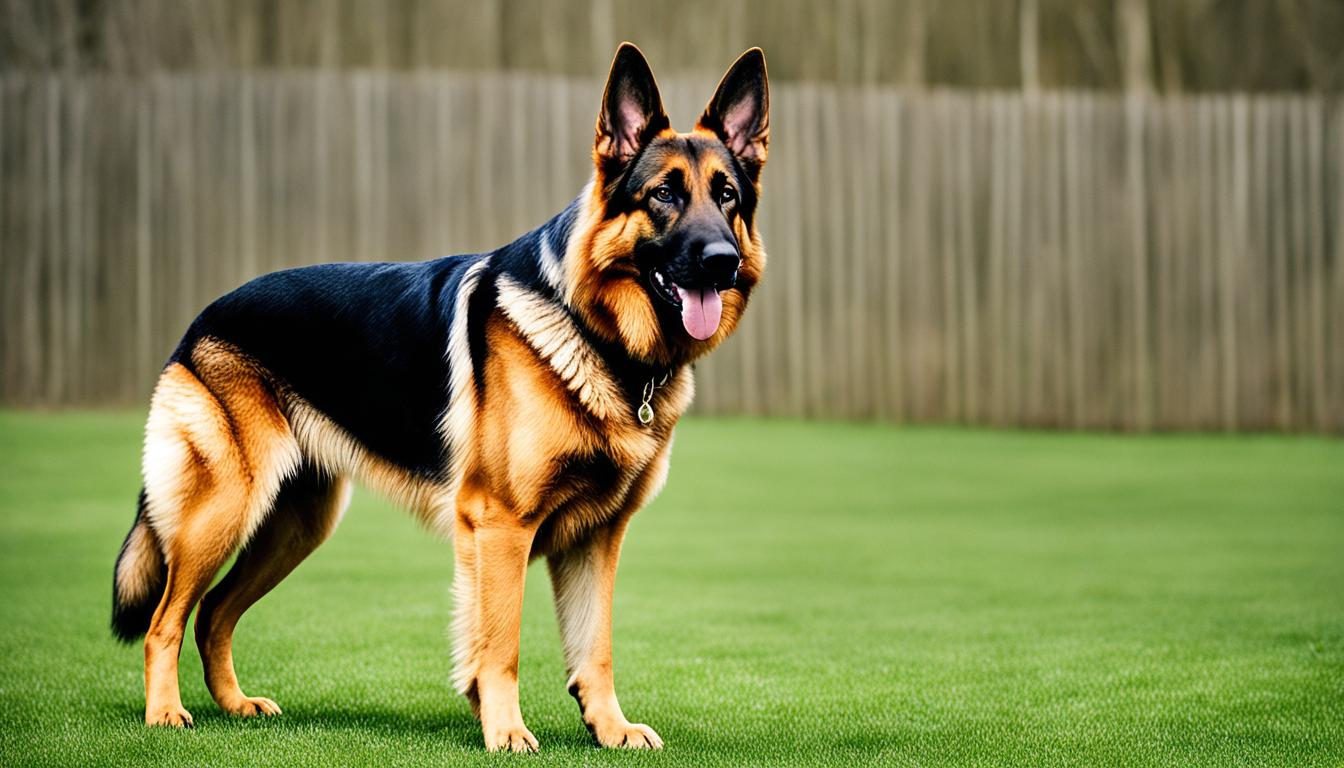German Shepherd B: Essential Breed Information
The German Shepherd breed stands as a testament to canine versatility and intelligence. Originating from Germany, these dogs have captured the hearts of many with their loyalty and strength. We find that German Shepherd characteristics include a muscular build, erect ears, and a thick double coat that comes in various colors. Their size is impressive, with males typically standing 60 to 65 cm tall and females ranging from 55 to 60 cm at the withers.
When it comes to German Shepherd care, we understand the importance of proper training and socialization. These dogs thrive on mental stimulation and physical exercise, requiring at least two hours of activity daily. Their working dog heritage makes them excel in roles such as police work, military service, and as assistance dogs. However, they’re equally content as loving family companions when given the right attention and care.
Key Takeaways
- German Shepherds originated in Germany and were bred for working purposes
- Males typically measure 60-65 cm, while females range from 55-60 cm at the withers
- The breed requires a minimum of 2 hours of daily exercise
- German Shepherds excel in various roles, from service dogs to family companions
- Proper training and socialization are crucial for their well-being
- The breed is known for its intelligence, loyalty, and versatility
Origins and History of the German Shepherd Breed
The German Shepherd history is a fascinating journey that begins in 19th century Germany. These loyal companions were originally bred for herding sheep and cattle, showcasing their intelligence and adaptability from the start.
Development in 19th Century Germany
The German Shepherd origin can be traced back to traditional herding and farm dogs in Germany. Breeders aimed to create a versatile working dog with superior intelligence and physical capabilities. By the late 1800s, their efforts had produced a distinct breed that would soon capture hearts worldwide.

Captain Max von Stephanitz’s Role
In 1899, Captain Max von Stephanitz played a pivotal role in standardizing the breed. He purchased a dog named Horand von Grafrath for 200 German gold marks, registering him as the first German Shepherd Dog. Horand’s bloodline forms the foundation of nearly every German Shepherd alive today.
Introduction to the United States
German Shepherds made their way to the United States in the early 1900s. The American Kennel Club officially recognized the breed in 1908. Their popularity soared during World War I, where they served as war dogs. Famous canine movie stars like Rin Tin Tin and Strongheart further cemented their place in American hearts.
“The German Shepherd Dog is a breed of large-sized working dog that originated in Germany.”
Today, German Shepherds continue to be cherished companions and invaluable working dogs, a testament to their rich history and exceptional qualities.
Physical Characteristics and Appearance
German Shepherd characteristics are distinctive and easily recognizable. These dogs are known for their strong, muscular build and wolf-like appearance. We’ll explore the key features that make this breed stand out.
Size and Weight
German Shepherds are large dogs with impressive statures. Males typically stand 23-26 inches tall at the withers, while females measure 21-24 inches. The weight range for males is 66-88 pounds, and females weigh between 48-71 pounds.
| Gender | Height (inches) | Weight (pounds) |
|---|---|---|
| Male | 23-26 | 66-88 |
| Female | 21-24 | 48-71 |
Coat Types and Colors
The German Shepherd appearance is characterized by a double coat that can be either medium-length or long. Their coat colors vary, including black and tan, sable, and solid black. Some rare German Shepherds even sport a piebald coat, known as the “panda” type.

Distinctive Features
German Shepherds have several unique features that contribute to their striking appearance. They possess erect ears, almond-shaped brown eyes, and a long, fox-like tail. Their body is slightly longer than tall, with a sloping topline and strong, well-muscled limbs. The breed’s head is proportionate, with a long muzzle equal in length to the skull.
- Erect ears
- Almond-shaped brown eyes
- Long, fox-like tail
- Sloping topline
- Strong, muscular build
These physical traits combine to create the iconic German Shepherd appearance that has made the breed popular in various roles, from family companions to working dogs in police and military services.
Temperament and Personality Traits
The German Shepherd temperament is a blend of intelligence, loyalty, and courage. These dogs rank high in popularity across the USA, Australia, New Zealand, Canada, and the UK. Their versatile nature makes them ideal for various roles, from family companions to working dogs.
German Shepherd personality traits include being energetic, outgoing, and stable. With proper training and socialization, they become gentle family pets and steadfast guardians. Their high energy levels demand ample mental and physical stimulation to thrive.
- Loyal and protective
- Intelligent and trainable
- Energetic and active
- Confident and courageous
We find that German Shepherds excel in police work, assistance, therapy, and scent detection. Their eagerness to please and strong work ethic contribute to their success in these fields. While they form strong bonds with their families, they can be aloof with strangers, emphasizing the need for early socialization.
“Proper training and socialization lead well-bred German Shepherds to be gentle family pets and steadfast guardians.” – American Kennel Club
It’s important to note that German Shepherd temperaments can vary based on breeding lines and socialization. Some lines may produce dogs better suited for competitive protection sports, while others focus on creating milder-mannered family companions. Choosing a German Shepherd that aligns with your lifestyle is crucial for a harmonious relationship.
Intelligence and Trainability of German Shepherds
German Shepherd intelligence is truly remarkable. These dogs rank third among 138 AKC-recognized breeds in Stanley Coren’s research on canine smarts. They’re part of the “brightest dogs” group, learning new commands in under 5 repetitions and performing known commands correctly over 95% of the time.
Working Dog Capabilities
German Shepherds excel as working dogs. Their intelligence stems from their working DNA, with genes accounting for 51% and environment for 49%. This makes them ideal for roles like police work, military service, and guide dogs for the visually impaired.
Obedience and Responsiveness
German Shepherd training is highly effective due to their eagerness to please. They learn five times faster than average dogs and are twice as obedient. This breed thrives on having a purpose, which is crucial for their mental stimulation.
Socialization Needs
Early socialization is key for German Shepherds. It helps prevent excessive guarding behavior and promotes a well-rounded temperament. Exposing them gradually to various situations develops good manners and friendly behavior towards strangers and other animals.
| Trait | Description |
|---|---|
| Intelligence Ranking | 3rd out of 138 breeds |
| Learning Speed | 5x faster than average dogs |
| Command Performance | Over 95% accuracy |
| Daily Exercise Needs | At least 2 hours |
| Socialization | Crucial from early age |
Health Concerns and Lifespan
German Shepherd health is a critical aspect to consider when owning this breed. A 2017 study revealed that 63% of U.K. German Shepherds had at least one disorder, highlighting the importance of understanding potential health issues. The average German Shepherd lifespan ranges from 7 to 10 years, with some reaching 13 or 14 years, often accompanied by chronic health problems like arthritis.
Hip and elbow dysplasia are common concerns, affecting about 21% and 19% of German Shepherds, respectively. These conditions can lead to pain and mobility issues. Degenerative myelopathy, a hereditary disorder, typically affects middle-aged to older dogs. Digestive problems, including bloat (gastric dilatation-volvulus), are serious risks, with 25-30% of affected dogs not surviving this emergency condition.
We can’t overlook other health issues such as autoimmune diseases, heart conditions, and various eye problems. Cancer is another significant concern, with hemangiosarcoma, osteosarcoma, and lymphosarcoma being common types. Regular veterinary check-ups, genetic screening, and maintaining a healthy lifestyle are crucial for managing German Shepherd health and potentially extending their lifespan.
FAQ
What is the origin of the German Shepherd breed?
What are the physical characteristics of a German Shepherd?
What is the temperament of a German Shepherd like?
How intelligent and trainable are German Shepherds?
What are some common health concerns for German Shepherds?
What grooming is required for a German Shepherd?
Source Links
- Breed Standards – United Schutzhund Clubs of America
- German Shepherds
- German Shepherd | Royal Canin
- No title found
- German Shepherd
- German Shepherd | Dog Breed, Description, Temperament, & Facts
- German Shepherd Dog Breed Information
- German Shepherd Dog Breed – Facts and Traits | Hill’s Pet
- German Shepherd Breed Guide | Pet Parenting
- The German Shepherd
- Elite Canine | www.do-behave.com | Dog Training Services
- German Shepherds: What’s Good About ‘Em, What’s Bad About ‘Em
- Are German Shepherds Smart?
- Common German Shepherd Behavior Problems / Personality Traits
- German Shepherd | Edgard & Cooper
- Everything You Need To Know About German Shepherd Common Health Issues
- What to Know About German Shepherds
- German Shepherd Health Problems | Feeding | Daily Care







